No area of the New York Rangers played a bigger role in the front office’s decision to announce a full-scale rebuild in Feb. 2018 than the blue line. Choked with bloated contracts and aging, slower players who were either in decline, hadn’t lived up to their big deals or both, the mess on defense was a major indicator for team management that it was time to run up the white flag on the previous era and start anew.
The task of addressing the much-maligned defense corps appeared daunting at the time. The process had actually begun the previous summer when fan-favorite Dan Girardi was bought out, and the Rangers’ salary cap is still on the hook for three more seasons after this one due to that painful course of action. It hardly alleviated the problem, however, with the contracts of Kevin Shattenkirk, Brendan Smith and Marc Staal still on the books when the organization formally announced its intention to start over.
The Rangers will be living with all three of those deals in some form for at least a few more seasons. But what general manager Jeff Gorton has put together for 2019-20 – less than two years since the teardown process began in earnest – represents a remarkable transition to the future, with his flurry of trades forging a mobile as well as physical groundwork on defense, perhaps for years to come.
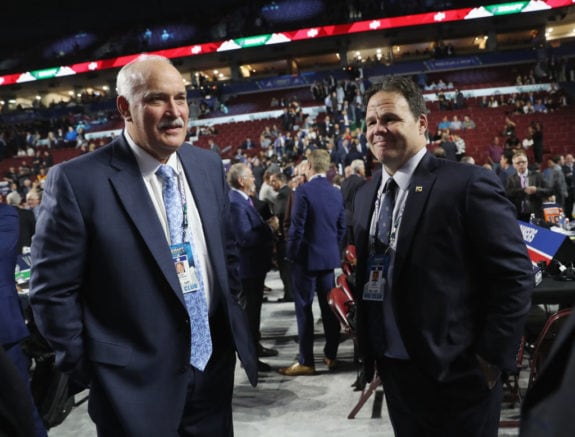
That’s largely because upon undertaking the rebuild with which he was charged, Gorton recognized the extent of the problem on defense and thus put a good amount of his focus into fixing it.
The name of game in the modern NHL is speed out of the back end, and lo and behold, the Rangers finally have it. The arrival of personnel who could provide that and other key elements on the blue line really started in June 2017, the same month Girardi was bought out, when Gorton acquired Tony DeAngelo as part of the blockbuster Derek Stepan trade with the Arizona Coyotes. The 24-year-old DeAngelo, the 19th pick in the 2014 Draft, was an exceptional offensive talent whose questionable makeup made him obtainable.
Next up was prospect Ryan Lindgren, acquired Feb. 25, 2018 as a key part of the Rick Nash trade with the Boston Bruins. The following day delivered Libor Hajek, with Gorton pulling the trigger on the Ryan McDonagh-J.T. Miller trade with the Tampa Bay Lightning that brought back the highly regarded 37th pick of the 2016 Draft, along with other assets.
Gorton Pulled off Heist with Fox, Trouba Additions
Then came 2019. Gorton received rave reviews for his acquisition of the rights to Harvard defender Adam Fox for second- and third-round picks April 30, and the GM then stunned the league by picking up top-pair defenseman Jacob Trouba, like Fox a coveted right-sider, from the Winnipeg Jets in a trade in June. Combined with DeAngelo’s presence, those two deals gave the Blueshirts three right-handed shots on defense after several years of having to use left-handers on the right – hardly an ideal situation.
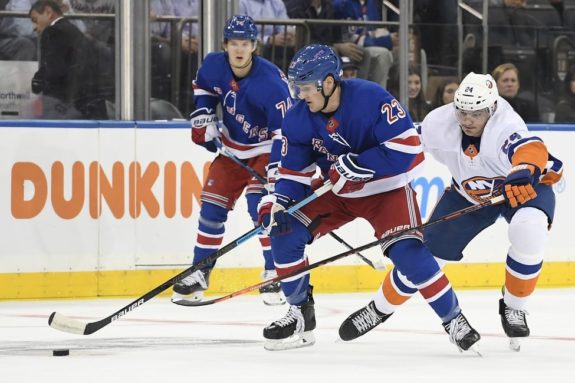
All of those acquired players have worked their way into regular roles this season. The process has seen plenty of bumps so far, with the group still finding its way in its own end. Yet, the Rangers are playing more and more games now in which the revamped defense has flexed its ability to deliver a type of impact that Rangers defenses hadn’t before.
“This modern-day NHL, you need five guys involved offensively,” coach David Quinn said. “We’ve got the ability to have some of our guys get involved offensively. But some of it (comes) off good defense.” (from ‘Rangers Defensemen Lead the League in Unexpected Category’, New York Post, 12/9/19)
For the ninth time in Rangers history, all six defensemen registered at least a point in the same game as the club opened a four-game western road trip with a 5-0 victory over the Vegas Golden Knights on Sunday. Each defender recorded one assist with Trouba also adding a goal, giving him two goals and five assists in his past six games and 10 points in his previous 10.
The development of DeAngelo (7 goals, 14 assists, plus-2 rating) from promising problem child into rising pro under Quinn’s firm hand, the instant poise of the 21-year-old rookie Fox (5 goals, 11 assists, plus-6) and the veteran presence of Trouba, who’s just 25 (5 goals, 12 assists) has in some ways made the Rangers unrecognizable on defense.
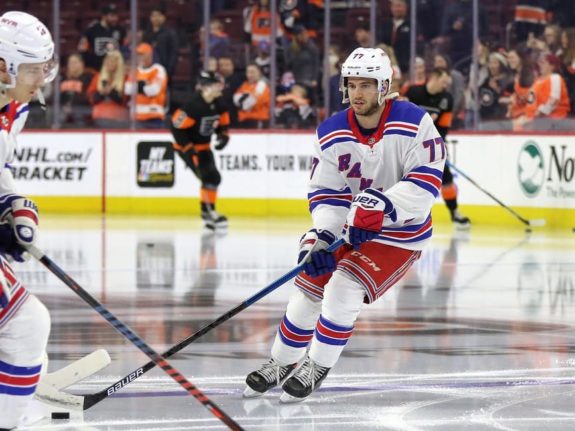
The mobility and quickness have shown up prominently in the Rangers’ dangerous power play, which ranked 12th in the NHL at 20 percent after Sunday’s games. Fox’s eight points on the power play lead the Blueshirts, while DeAngelo and Trouba have recorded six points apiece with the manpower advantage. That’s helped the Rangers compile an NHL-best 86 points from their defense through the first 29 games.
It’s not just the power play, however. The Rangers’ breakouts from their own zone are becoming much quicker and crisper (though again, this young team doesn’t deliver that on a regular basis yet). Along with the offensively talented Fox, DeAngelo and Trouba, the skating ability of 25-year-old Brady Skjei – who appears to be finally finding his game for the first time in three seasons – along with the currently injured Hajek, 21, has transformed what the Rangers do in the defensive as well as offensive zone.
Trouba, Lindgren Add Bite to Skilled Defense
Despite this youthful group’s inconsistency, the potential was clear against the Golden Knights. The Rangers routinely skated around and by forecheckers in quickly clearing their zone, and pinpoint passes also prevented the Golden Knights from developing much sustained pressure after the first period.
In the offensive zone, DeAngelo, Fox and Trouba have contributed increased lateral movement and evasiveness with the puck at the points and above the circles. DeAngelo’s control of the puck on the Rangers’ first goal Sunday, in which he broke down the Vegas defense for Artemi Panarin to convert on a prime chance from the top of the right circle, demonstrated the new dimension that these young blueliners have brought.
Ah, but a blue line can’t thrive on speed alone, right? Haven’t the Rangers struggled badly to keep opposing big bodies out of the crease for what seems like forever?
Enter Trouba and Lindgren, who have given the defense some desperately needed bite. The Oct. 28 recall of Lindgren from the American Hockey League, in particular, has been critical, his refusal to back down or be pushed around in front of his own goal appearing to be infectious to his teammates. The 21-year-old Lindgren looks like the defense corps’ sole throwback player, a blue-collar stay-at-home D-man who understands his responsibilities lie largely around his own goal.
Perhaps Lindgren’s approach has sparked a back-to-basics move from Trouba, who brought a reputation for tough play with him from the Jets but has been somewhat slow to live up to it as he settles in during his first season in New York. That facet of the 6-foot-3, 209-pound Trouba’s game was certainly on display in a 4-0 victory over the New Jersey Devils on Nov. 30, however, when he turned in a downright nasty and physically dominant game in his own zone.
The traffic jam in front of Henrik Lundqvist’s net has been almost comical in recent seasons, the Rangers being either unwilling or lacking the personnel to clear away forwards looking for tip-ins and rebounds. That’s also led to The King and his understudies often finding themselves run over or buried under piles of players in the crease.
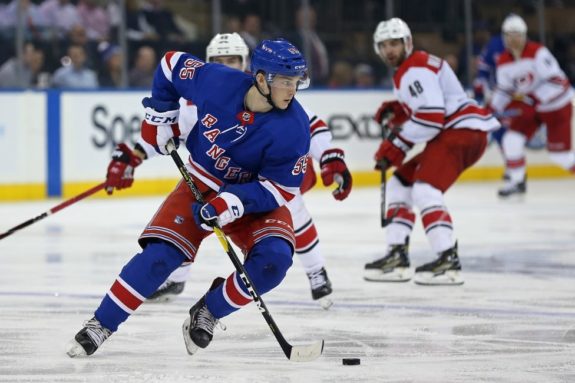
The club succeeded at protecting its net again Sunday, this time against a typically strong, north-south Western Conference club.
“It’s a big heavy team (to be) boxing guys out,” forward Chris Kreider said after the win over the Golden Knights. “They have big bodies and they get to the net. (We) were picking up sticks, breaking up plays. I think it was a testament to how well our ‘D’s played.” (from ‘Alex Georgiev Stellar Again in Rangers’ Takedown of Knights’, New York Post, 12/8/19)
Fast, Powerful Miller Can Further Boost New-Look Blue Line
With more of that on tap against the Los Angeles Kings, San Jose Sharks and Anaheim Ducks on this trip, the Rangers will continue to be tested on whether they can keep the shooting lanes in front of their goaltender clear.
The youthful transformation of the defense could get another boost in the coming seasons, when K’Andre Miller is expected to join the organization from the University of Wisconsin. The 6-foot-3, 200-pound Miller, who the Rangers selected 22nd overall in 2018 after trading up four spots, boasts the skating ability, size and strength to impact the blue line with both skill and physical play, as Trouba does.
For now, the defense’s past remains prominent in 2019-20 and beyond. Staal is still around, with another season at $5.7 million on his contract remaining after this one. The 32-year-old veteran has still been able to help with his leadership, size and experience, but he’s easily the least mobile option at the back end and faces a reduced role going forward.
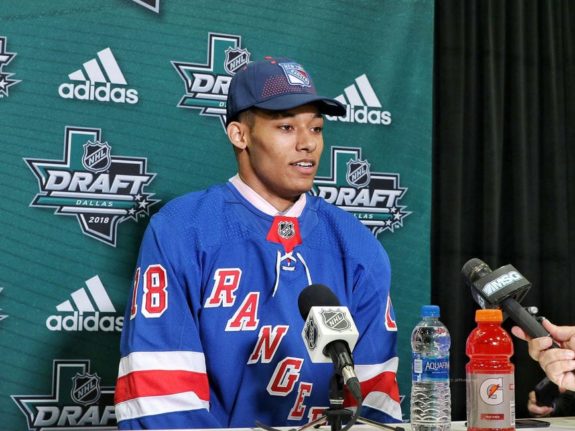
Shattenkirk was bought out after two disappointing and injury-plagued seasons in New York, and he’ll cost the club a staggering $6,083,333 million against the cap next season as the price for doing so. Smith has resurrected his career by reinventing himself as an effective fourth-line forward who slides back to defense to kill penalties, but he costs $4.35 million against the cap this season and next.
Quinn, however, won’t allow any of that to skew the development of the Rangers’ multi-skilled new blue line – the kind that was sorely needed over the past few seasons and which seemed like a pipe dream just 22 months ago.